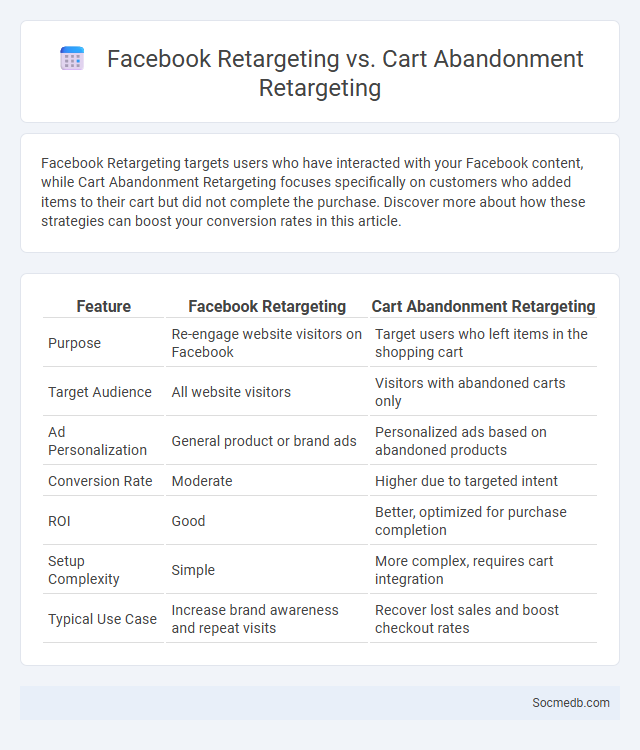
Photo illustration: Facebook Retargeting vs Cart Abandonment Retargeting
Facebook Retargeting targets users who have interacted with your Facebook content, while Cart Abandonment Retargeting focuses specifically on customers who added items to their cart but did not complete the purchase. Discover more about how these strategies can boost your conversion rates in this article.
Table of Comparison
| Feature | Facebook Retargeting | Cart Abandonment Retargeting |
|---|---|---|
| Purpose | Re-engage website visitors on Facebook | Target users who left items in the shopping cart |
| Target Audience | All website visitors | Visitors with abandoned carts only |
| Ad Personalization | General product or brand ads | Personalized ads based on abandoned products |
| Conversion Rate | Moderate | Higher due to targeted intent |
| ROI | Good | Better, optimized for purchase completion |
| Setup Complexity | Simple | More complex, requires cart integration |
| Typical Use Case | Increase brand awareness and repeat visits | Recover lost sales and boost checkout rates |
Introduction to Retargeting: Definition and Concepts
Retargeting is a digital marketing strategy that targets users who have previously interacted with a brand's website or social media content but did not complete a desired action, such as a purchase or sign-up. This technique uses cookies or tracking pixels to collect user behavior data, enabling advertisers to display personalized ads across platforms like Facebook, Instagram, and Google Ads. By reinforcing brand presence and encouraging conversions, retargeting significantly boosts return on investment (ROI) and customer engagement rates.
What is Facebook Retargeting?
Facebook Retargeting is a powerful advertising strategy that targets users who have previously interacted with Your website or app, increasing the chances of conversion by showing relevant ads tailored to their interests. It uses Facebook Pixel data to track user behavior and create custom audiences, allowing precise ad delivery based on past engagement. Implementing Facebook Retargeting helps maximize ad spend efficiency and boosts return on investment by re-engaging warm leads.
Cart Abandonment Retargeting Explained
Cart abandonment retargeting leverages consumer behavioral data to re-engage potential buyers who leave online stores without completing purchases. Utilizing targeted ads on social media platforms like Facebook and Instagram, this strategy increases conversion rates by reminding users of unpurchased items through personalized offers and dynamic product displays. Studies show cart abandonment retargeting can recover up to 30% of lost sales, making it a critical component of e-commerce marketing.
General Retargeting: Scope Beyond Facebook
General retargeting extends beyond Facebook by reaching users across multiple platforms like Google Display Network, Instagram, Twitter, and LinkedIn, enhancing your ad visibility and conversion potential. By leveraging cookies and pixel tracking, you can effectively re-engage visitors who interacted with your site but didn't complete a purchase or desired action. This multi-channel retargeting strategy maximizes your brand's exposure and drives higher ROIs through personalized ad experiences tailored to user behavior across diverse digital environments.
Key Differences Between Facebook Retargeting and Cart Abandonment Retargeting
Facebook retargeting targets users based on their interaction with a brand's Facebook content or ads, using custom audiences to re-engage visitors across Facebook's platform. Cart abandonment retargeting specifically targets users who have added items to their online shopping cart but did not complete the purchase, aiming to recover lost sales through personalized reminders or discount offers. Key differences include the targeting criteria--general engagement versus cart activity--and the intent of the messaging, with cart abandonment focusing on conversion recovery and Facebook retargeting broader brand awareness or engagement goals.
Pros and Cons of Facebook Retargeting
Facebook retargeting offers precise audience targeting by leveraging user behavior data, increasing conversion rates through personalized ads shown to users who have previously interacted with a brand. This method enhances ROI by reducing ad spend wastage and boosting brand recall, making it an efficient tool for marketers. However, it faces challenges such as potential privacy concerns, ad fatigue among users, and reliance on a stable Facebook algorithm that can affect ad delivery and performance.
Pros and Cons of Cart Abandonment Retargeting
Cart abandonment retargeting on social media significantly boosts conversion rates by reminding potential customers of their unfinished purchases, leveraging personalized ads to recover lost sales. However, it can also lead to consumer annoyance and ad fatigue due to repetitive targeting, potentially damaging brand perception. Balancing frequency and relevance in retargeting strategies is essential for maximizing ROI while maintaining positive user engagement.
When to Use Facebook Retargeting vs Cart Abandonment Retargeting
Facebook retargeting is ideal for reconnecting with users who have previously engaged with your brand, scrolling through your content or visiting your website, helping increase brand recall and nurturing interest. Cart abandonment retargeting specifically targets users who added items to their shopping cart but did not complete the purchase, focusing on driving conversions and recovering potentially lost sales. Understanding the difference allows you to tailor your marketing strategy to reach Your audience at the right moment, maximizing engagement and ROI.
Best Practices for Optimizing Retargeting Campaigns
Effective retargeting campaigns leverage segmented audience data to deliver personalized ads that increase conversion rates. Utilizing frequency capping prevents ad fatigue by limiting how often users see the same ad, ensuring engagement without annoyance. Employing dynamic creatives tailored to user behavior enhances relevance, boosting click-through rates and overall campaign ROI.
Measuring Success: Key Metrics for Retargeting Strategies
Tracking click-through rates (CTR) and conversion rates are essential metrics for measuring the success of your social media retargeting strategies. Analyzing customer engagement through impressions and frequency helps optimize ad delivery and budget allocation. Monitoring return on ad spend (ROAS) provides insight into the overall effectiveness and profitability of your campaigns.
 socmedb.com
socmedb.com